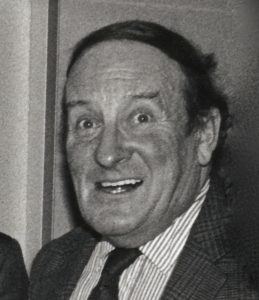
For King George V’s CRSC charter to Tarbert on 18 May 1972, Jim Aikman Smith climbed the hill above the pier to take this atmospheric photo. Copyright The Estate of James Aikman Smith/courtesy of Lawrence Macduff
In the second instalment of his ‘Confessions of a cameraman’, Lawrence Macduff recalls his friendship with Jim Aikman Smith (1929-1996), a ship photographer of great renown and one of the most idiosyncratic enthusiasts of modern times. Below Lawrence’s tribute we publish extracts from a 1981 interview with Jim and an obituary written shortly after his death.
I can safely say that my ship picture-taking missions began during my boyhood days on the Clyde, but over the next 15 years or so I met many other enthusiasts who were doing something similar. By far and away the most dedicated of these guys (for it was an absolutely male hobby) was the late Jim Aikman Smith.
Born in Edinburgh in 1929 into a family with some resources, he gained his interests through cruising as a youngster on a yacht owned by a member of his family. His travels encompassed the Clyde and the Western Isles, but it was the latter area that principally fired up his interest. He trained as a solicitor, working in the time I knew him in estate conveyancing with Brodies, a well known Edinburgh firm. We regularly exchanged pictures in the 1980s and 1990s, but the earliest examples of his that I have date from 1960.
My reason for mentioning him in these notes is the degree of effort he put into the hobby. I learned much from him, in particular how to improve my compositions of ship photographs.
Jim cultivated contacts ashore and afloat all over the MacBrayne service network, but had huge additional advantages over most other enthusiasts. First, he was a bachelor. Second, he appeared able to manage his working hours in such a way that, having elicited that an unusual ship movement was to take place, at the drop of a hat he could vanish from his office and drive, overnight if need be, to a particular location, where he would be able to secure a rare if not unique shot of one or other MacBrayne ship making an unscheduled call at a port either rarely or never before visited.
To allow him to operate in such a way, his car was always in a state of readiness. For a long time he used the Renault 4TL model and it is an odd coincidence that during the time I knew him, though not particularly because of this car, that I became attached to Renaults and still am to this day. Because the 4 was in fact a small estate car, it suited Jim’s needs admirably because within the length of the vehicle, he could readily accommodate a sleeping bag and blankets, fully stretched out, as well as an adequate supply of canned foods.
He always had a trusty dog with him, for many years an indeterminate hound with Alsatian-like markings that went by the name of Sullivan, a wonderful and patient companion.

Jim on the hill above the pier at Tarbert, Loch Fyne, in May 1970, photographed ‘in standard pose’ by Lawrence Macduff from the upper deck of King George V
When Sullivan, named after Jim’s fondness for Gilbert and Sullivan light opera, passed away, another dog looking not dissimilar arrived and was named Gilbert. One of my most vivid memories of Jim dates from around 1982 when, early one morning (I had left Glasgow at 5am) I found him on Oban’s Corran Esplanade in brilliant sunshine, dog tethered to a lamp post, with the redoubtable Jim frying sausages inside the car, shrouded by smoke, defying any semblance of comfort, relishing in the state of the weather which had already allowed him to secure his desired picture. I cannot recall what ship it was, even though I had come north to do something similar, but the memory of Jim as I’ve described him epitomised all that this hobby was about!
My own interest in taking pictures of the steamers long predated my first acquaintance with Jim Aikman Smith, which took place in 1967 at the formation of the West Highland Steamer Club, an organisation which survives to this day. Jim passed away in 1996. It is a sobering thought that, as I write up these notes, I am a year older than he was when he died, and am greatly saddened in many ways that I never thought to encourage him to write up his missions, largely because I’d never given a second thought to doing so for myself – till now!
At the time of his passing, an excellent obituary was penned by John Macleod from Harris, then a journalist with The Herald newspaper. Many readers of this piece will have their favourite recollections of Jim, as do I, but amongst his many missions, two were exceptional.
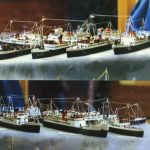
Jim’s ship models, pictured at a CRSC exhibition at Kelvingrove in 1969, were kept at home in two large display cabinets: as soon as a vessel was withdrawn from the fleet, its model would be carefully taken out of one cabinet and placed in the adjacent one.
He used to carry with him a small inflatable dinghy that gave him access to locations without road access. Perhaps his most famous such expedition was at the narrows in Loch Sunart, opposite Glenborrodale. Having brought the dinghy ashore on the islet of Risga, he climbed — no doubt at some considerable peril to his welfare — to the top of this rocky outcrop from which he took the most stunning photographs of the passing King George V on one of her occasional cruises up this beautiful loch.
Another escapade involved a similar mission into the waters of Loch Craignish, which featured on the Six Lochs cruise route. I never saw his craft at close quarters, nor do I recall if Jim was a competent swimmer, but the inflatable was irreverently dubbed his ‘daft duck’ because of the difficulty of steering the blighter in a straight line.
This term was perhaps unkindly bestowed on CalMac’s ‘Island Class’ octuplets, and here was one of Jim’s quirks: he would expend every bit as much effort on photographing them as he would on the main fleet, because they had funnels, but as the successor ‘Lochs’ did not, he was much more reluctant to chase after them.
His influence resulted in their receiving red painted wheelhouses, making for a considerable aesthetic enhancement to their appearance. The ‘Island’ class ferry Rhum benefited from another of Jim’s missions: thanks to his influence, uniquely she had her red funnel colour carried down to bridge deck level.
Read John Macleod’s affectionate memoir of Jim Aikman Smith in The Herald 26 March 1996

Jim Aikman Smith was CRSC President in 1974-5, but he played a much more prominent role in the West Highland Steamer Club, of which he was a founder member: he served as Honorary Secretary and guiding spirit for more than 25 years. This photo, taken at WHSC’s 21st birthday lunch aboard Glen Sannox in 1989, shows Jim (directly behind the cake) very much at the centre of things, though he was the only person in the picture never to have held the position of WHSC President. (Left to right) Ian McCrorie, Robin Boyd, Robert Cleary, Eric Schofield, Robin Love, Ian Hall, JAS, Walter Bowie, Willie Ross, Lawrence Macduff, Sir Donald Maclean. Photo reproduced by courtesy of Robin Love
‘I’M THE NUTTIEST OF THEM ALL’
Jim Aikman Smith was the subject of a quirky profile in the February 1981 edition of The Scots Magazine. Written by John Rundle and titled ‘Ships with Everything’, the article was illustrated by Jim’s own photographs.
Responding to a question about west coast steamer enthusiasts, Jim declared “I suppose I’m the nuttiest of them all.” His lifetime obsession, he said, began at Tighnabruaich where his father had a yacht, “and from there it just grew. At first I used a box camera, but in 1960 I invested in something more advanced to take colour.”

King George V and Clansman in dry dock at Lamonts, Greenock, on 14 April 1974. Copyright The Estate of James Aikman Smith/courtesy of Lawrence Macduff
His overriding aim, he explained, was to photograph west coast ships wherever they sailed — best of all involving unusual routes, special sails and new ports of call.
Various exploits were recounted, including the occasion when Jim climbed an unfinished building in Greenock to take a photo of King George V in dry dock, only to be met on his return to ground level by a posse of policemen who thought he might be planting a bomb on their new HQ.
Then there was the time he chased round the lower Thames estuary in search of Anzio 1 (formerly Lochinvar), only to be confronted by a uniformed official on a naval industrial estate in Sheerness, who told him he was not allowed to leave on foot — the vessel and its connecting bus both having departed while Jim was busy clicking away, with the next bus not due for another 24 hours. He had to draw on his legal training to explain his predicament and execute a deft escape.
He told the Scots Magazine interviewer that, although he lived near the Forth, he restricted himself to photographing vessels of the former Caledonian Steam Packet Company and David MacBrayne “and of course Waverley”. If he widened his field of vision, he would “just go crazy”.
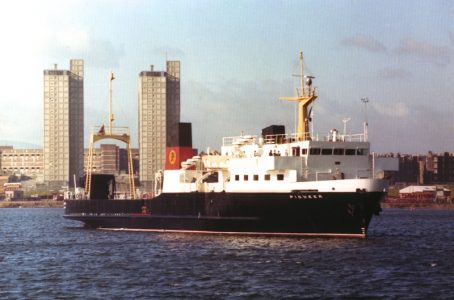
One of Jim’s rare east coast photographs: Pioneer emerges from her builder’s yard at Leith on 1 August 1974. Copyright The Estate of James Aikman Smith/courtesy of Lawrence Macduff
On the Forth he had made an exception for photographing Pioneer and Claymore while they were still at their Leith builders, Robb Caledon. He was not interested in photographing the loch steamers Sir Walter Scott or Maid of the Loch, because “they’re rather limited in the places they can turn up.”
Referring to the famous occasion when he captured King George V sweeping through the Risga Narrows in Loch Sunart, Jim said he had rowed out to the island fully expecting the MacBrayne turbine to sail mid-channel — but instead she came right along the side of the island close by his cliff-top stance. “That really took me by surprise. It wasn’t until later I learned that this was where the deep water lay.”
Not all Jim’s exploits were successful, and there was a lot of waiting around. When Pioneer headed for the west coast on her delivery voyage in 1974, for example, he lay in wait all day at Kyle of Lochalsh to photograph her coming through the narrows, but the vessel did not turn up. It was only after he had driven all the way back to Edinburgh that he learned her actual route had taken her round the west of Skye. In 1980, he remedied the omission by capturing Pioneer both at Kyle and Kylerhea.
Jim, who lived in the pre-digital age, said that when winter weather was too poor for photography, he preferred not to waste film. Most CalMac crews turned a blind eye to his eccentricities, but his appearance at Mallaig on one occasion in the depths of winter caused some confusion. He had gone to photograph Loch Eynort, which appeared only for winter reliefs, and was mistaken for the engineer who had been summoned to mend her winch!

‘It really took me by surprise’: King George V passes through the Risga Narrows in Loch Sunart on 19 May 1969. Copyright The Estate of James Aikman Smith/courtesy of Lawrence Macduff
‘JIM’S IDIOSYNCRACIES WERE LEGION’
CRSC is grateful to Robin Love for making available the following unsigned obituary of Jim Aikman Smith, circulated after his death on 12 March 1996.
Jim Aikman Smith was born in 1929, a fact he kept very much to himself. He was the only son of Gavin Aikman Smith, a prominent accountant. His paternal grandfather had gifted Murrayfield to the Scottish Rugby Union. His mother died young but his father, of whom he was very fond, lived till a ripe old age. An uncle had donated a lifeboat to the RNLI. There was also a maiden aunt who died fairly recently: she was the last of Jim’s relatives.
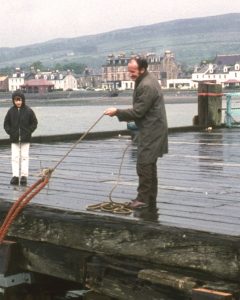
Jim takes the ropes at Helensburgh on 29 May 1971 for a CRSC charter of Countess of Breadalbane. Copyright Peter Reid
Educated at Edinburgh Academy and the University of Edinburgh, where he studied law, Jim was of an age to do National Service, which he endured in Tripoli for two years. Following a legal apprenticeship in 1955 he joined the firm which is now Brodies, and remained with them until his retiral in 1983. He was very highly regarded as one of the best conveyancers around, specialising in landed estates, from Dornoch and Ullapool to points west. Sometimes he was required to carry out his work in situ, but this was no great hardship to Jim as it got him into the country he loved so well. Sometimes his work had to be extended (as he had to record historical events for posterity….) but he always completed his quota for the firm on time and without fuss — and he was the eptiome of professionalism. He was much loved and well thought of by his colleagues who smiled at his endearingly eccentric ways.
He was interested not in all music, but specifically in Gilbert & Sullivan, whose operas he knew intimately. He was a past master at parodying the songs and his passion for G & S was such that his first two faithful dogs were called Sullivan and Gilbert.
But our most lasting memory of JAS is as a steamer enthusiast. It was all his father’s fault — his dad owned a boat which he kept in the west. From its decks the impressionable young man was fascinated by the paddle steamers, turbines and motor vessels which brought so much colour to the Clyde and Western Isles. It was a love affair that was to last until the day he died.
Until his late thirties Jim was not really part of the enthusiast fraternity: rather he became acquainted with the steamers themselves, their officers, their crews and their shore managers. While he retained a lively interest in the Clyde his main passion was David MacBrayne’s West Highland steamers. Not surprisingly he was a founder member of a small specialist group whose interests centred on this field. Soon, as Secretary, he took over more and more of the official functions until it was true to say that Jim was the West Highland Steamer Club. He arranged lecturers — many were the company’s servants he knew so well. He produced a calendar, and most importantly he produced the biannual contemporary Newsletter and reviews of former years.
The work that went into this was prodigious. He had contacts from Islay in the south to Lewis in the north; those who supplied him with information ranged from humble pier hands to Directors of the company, now of course Caledonian MacBrayne. He has out on record shipping movements in the MacBrayne/CalMac empire from 1939 up to 1995, i.e. he has recorded what every ship did every day in those 57 years, a labour of love indeed and something which will live on through the generations.
Jim’s idionsyncracies were legion. He was one of the last to change his thinking to decimal currency: £.s.d. was traditional and therefore superior. His conversion from fullscap to A4 was belated and only came about when printers refused still to recognise the old ways. He never did embrace the 24 hour clock and published everything in a.m./p.m. even though he had to translate from his informers and his readers had to do likewise.
And despite the fact that they played a pivotal role in the development of the shipping services, vessels without funnels did not interest him. Imagine his mental confusion when CalMac started painting wheelhouse red with black top to look like funnels. But Jim, as always, was pragmatic: he coped.
Jim’s collection of photographs is legendary. During his working life and even more in the early years of his retirement Jim received signals of impending events from his wide network of spies and nothing would come in the way of an original photograph, come hell or high water — literally. He has been known to have been cut off by the tide while perched on some precarious spot and has had to be rescued by rowing boat. He onced used his lilo to ‘swim’ out to Lismore Lighthouse for a unique shot. Jim was, as they say, ‘not short of a bob or two’ but when he went on one of his photographic safaris he eschewed hotels, going instead complete with his mobile home — whatever car he had at the time + sleeping bag, Primus stove and dog — and it was hard to believe in his other life he was a city lawyer: such was the enigma of James Aikman Smith.
During his retirement Jim had a cottage built near his locus operandi, at Rhemore in Morvern. On New Year’s Day he suffered a stroke but he was recovering well and the prognosis was good. Plans had been made to have him at Rhemore over Easter, but it was not to be. On the morning of Tuesday 12 March he suffered a massive heart attack and died virtually instantly. His dread had been that he might have been left with his faculties impaired but mercifully this did not happen. He did not think much about heaven in the orthodox religious sense: his idea of heaven was standing with cameras in hand, a bright sun behind and a red-funnelled steamer gracefully easing herself into a pier somewhere in the Hebrides — God’s own islands.
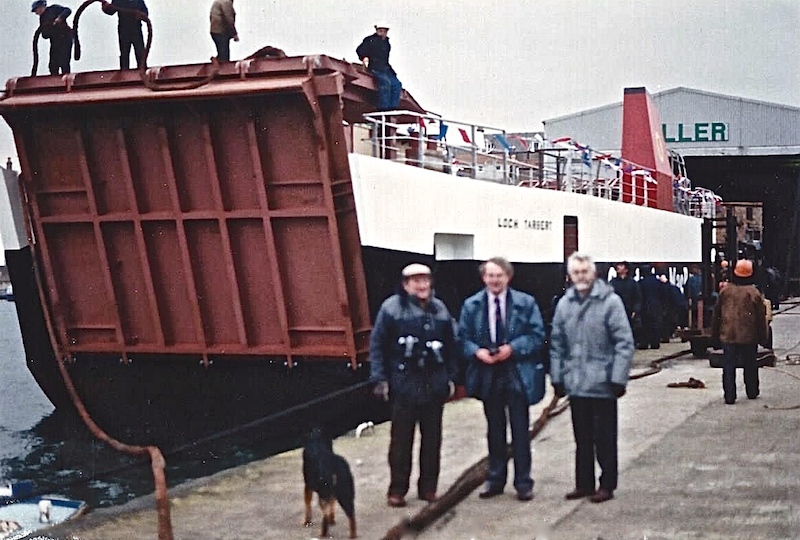
Wherever he went Jim took his cameras — and his dog. They are pictured (left) at the launch of Loch Tarbert at St Monans, Fife, on 20 February 1992, together with Walter Bowie (centre) and Iain MacArthur (right). Courtesy of Walter Bowie

Jim’s inflatable dinghy occupies a prominent position in his portrait of Lochfyne emerging from the Narrows in the Kyles of Bute on 15 September 1969. Copyright The Estate of James Aikman Smith/courtesy of Lawrence Macduff
Have you joined CRSC? It costs just £10 for the first year, and there are many benefits. Click here.












